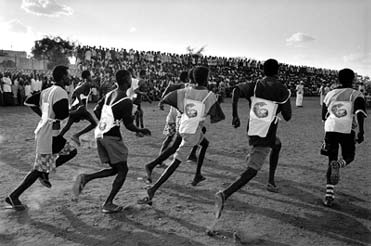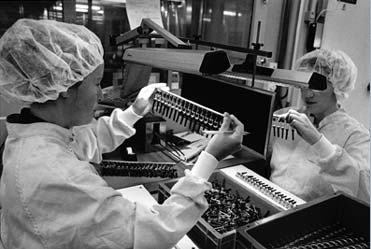
When a health campaign goes global, the numbers of people involved, in one way or another, can be mind-boggling. In this final intensive stretch, legions of health workers and volunteers put two billion doses of oral polio vaccine into at least 500 million children's mouths each year. To ensure success, the Global Polio Eradication Initiative must maintain worldwide momentum, while also preparing entire societies for these massive campaigns. This is handled by its communication side, called 'social mobilization.'
At its most basic, social mobilization means creating a dialogue. On the national and international levels, the Initiative focuses on promoting the importance of the campaign and maintaining the commitment of major partners, such as national governments and vaccine manufacturers. In countries carrying out National Immunization Days, this is a grass-roots effort to prepare communities for the immunization campaigns and, just as critical, to understand these communities' needs and concerns. This work is ongoing -- before, during and after the mass vaccinations.
The motivational and educational techniques are as varied as the world's cultures. The bottom line is: getting everyone committed and enthusiastic about polio immunization. Posters may work in some places. But what if a population is largely illiterate? Radio programmes are common, while poetry and songs work well in cultures with an oral tradition. Dance and theatre is often best in places that prize performance art. Sometimes traditional leaders, like kings or clerics, spread the word. Other times, it is celebrities, from football players to pop stars.
In 1999, the Initiative greatly expanded mass immunization campaigns in the remaining endemic countries. Almost overnight, demand for vaccine shot up from 700 million to nearly 2 billion doses a year, stretching production lines to their limits. UNICEF, the largest purchaser of vaccines in the world, directs this complex system through its supply headquarters in Copenhagen.
Careful coordination is required at all stages: with international partners regarding the overall process, with vaccine manufacturers on price and availability, and with individual countries to determine how much vaccine they need and when. Four manufacturers, three in Europe and one in Asia, produce hundreds of millions of oral polio vaccine doses each. One batch takes 12 to 18 months to make. Once tested and approved, it is shipped out.
This was once a measured exercise: manufacturers had reserved stocks of oral polio vaccine, which UNICEF purchased and distributed as needed. But because of the massive demand, the vaccine is now purchased off the production line and sent directly to the field.
The surge in demand leaves little margin for error. Vaccine availability is constantly changing, as are the immunization dates. If a batch of vaccine spoils, or production lags, the immunization campaigns could be delayed. This happened in Nigeria in 2000. To avoid postponements, the vigilance and cooperation of all parties – UN agencies, pharmaceutical companies and the endemic countries – is critical.

© Sebastião Salgado
Somalia
This race is one of several events promoting the March 2001 National Immunization Days in the town of Baidoa. The racers wear vests that show a child receiving a drop of oral polio vaccine.
The cold chain, the backbone of the polio eradication campaign, is a series of relay points that keep the vaccine cold - and potent – as it travels from manufacturer to child. Each link in the chain, usually a central warehouse or health clinic, is equipped with freezers and, if possible, emergency electrical generators that maintain temperatures for OPV at – 20 degrees Celsius. In countries where electricity and freezers abound, cold chains are easy to maintain.
The remaining endemic countries, however, are among the poorest in the world. They often lack basic infrastructure and many are wracked by armed conflict. Most have very warm climates. Take, for example, southern Sudan. The war-torn area has only 30 kilometres of paved roads, little or no electricity, and scorching heat reaching 50 degrees Celsius – some of the most extreme conditions faced by immunization teams. The Initiative has helped build an entire cold chain there, including a network of 230 solar refrigerators.
The introduction of the Vaccine Vial Monitor in the mid-1990s helped in maintaining the cold chain in ever more remote areas. Until then, health workers had limited means to determine if a vaccine was still potent. These monitors, with specially treated circles on vaccine vials that turn darker as the temperature rises, have eliminated the uncertainty caused by power outages, lengthy travel times, or simply a full day vaccinating under the hot sun. The vial monitor has thereby reduced vaccine wastage by an estimated 25 per cent.
Timing during each step of the cold chain is critical to ensure the vaccine only spends limited periods outside freezers. The clock starts ticking as soon as trucks leave the manufacturer. Transport planes should be waiting on the runway. To overcome customs delays, paperwork required for the international transfer of live biological material must be completely in order. The vaccinesÕ potency must be checked and rechecked all the way down the chain. If any link is broken, the vaccines could spoil, wasting the entire effort.

France
Vials of oral polio vaccine are inspected at the Aventis Pasteur production facility in the town of Marcy l'Etoile, near Lyon, before they are distributed to other countries.
 |